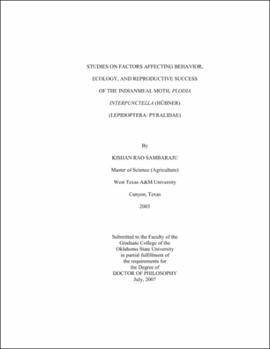| dc.contributor.advisor | Phillips, Thomas W. | |
| dc.contributor.author | Sambaraju, Kishan Rao | |
| dc.date.accessioned | 2013-11-26T08:23:48Z | |
| dc.date.available | 2013-11-26T08:23:48Z | |
| dc.date.issued | 2007-07 | |
| dc.identifier.uri | https://hdl.handle.net/11244/6753 | |
| dc.description.abstract | Scope and Method of Study: Responses of adult Indianmeal moths to various factors were studied in laboratory and simulated field conditions. Experiments assessed: 1) responses of gravid females to, substrates offering only physical stimuli or both physical and chemical stimuli, and wheat, Triticum aestivum L., extract-treated artificial substrates based on texture, number, size, surface area, and shape in 5.7 L plastic boxes under laboratory conditions, 2) correspondence of ovipositional host preferences of two Indianmeal moth populations to progeny survival based on their larval performances on eleven hosts in the laboratory, and 3) behavioral responses of adult Indianmeal moths, to light alone in small metal sheds, and to combinations of light and semiochemicals in a larger experimental arena. | |
| dc.description.abstract | Findings and Conclusions: Experiments conducted in small plastic boxes revealed that female Indianmeal moth respond to substrates that offer both physical and chemical stimuli, and the presence of either stimulus alone did not fully elicit the moths to lay maximum eggs. Substrates offering smooth, round textures received greater numbers of eggs, and glass beads 3-6 mm in size were preferred. Oviposition responses of the gravid females reached a peak when 150 or more extract-treated beads were used. Raised, smooth glass beads were preferred to flat substrates. In the second experiment, significant differences in larval development parameters were observed between the two populations on the eleven hosts. Ovipositional preferences of field-collected moths corresponded with their larval performances, which was not the case with moths from a long-term laboratory colony. Adult Indianmeal moths responded to ultraviolet (UV), green or white lights by orienting to areas illuminated by these lights compared to dark. However, trap captures of adult moths were always higher in UV light traps. When green or UV light was combined with semiochemical(s), no significant increases in trap captures occurred. Attraction of adult moths of either sex to UV light was clearly affected by the presence of a strong attractant. Oviposition experiments found that 24 h of continuous light inhibits oviposition and that a light intensity above 8 lux during the 'dark' phase of a light:dark cycle also inhibits oviposition. | |
| dc.format | application/pdf | |
| dc.language | en_US | |
| dc.rights | Copyright is held by the author who has granted the Oklahoma State University Library the non-exclusive right to share this material in its institutional repository. Contact Digital Library Services at lib-dls@okstate.edu or 405-744-9161 for the permission policy on the use, reproduction or distribution of this material. | |
| dc.title | Studies on factors affecting behavior, ecology, and reproductive success of the indianmeal moth, Plodia interpunctella (Hubner) (Lepidoptera: Pyralidae) | |
| dc.contributor.committeeMember | Giles, Kristopher L. | |
| dc.contributor.committeeMember | Dillwith, Jack W. | |
| dc.contributor.committeeMember | Payton, Mark E. | |
| osu.filename | Sambaraju_okstate_0664D_2363 | |
| osu.accesstype | Open Access | |
| dc.type.genre | Dissertation | |
| dc.type.material | Text | |
| dc.subject.keywords | substrate stimuli | |
| dc.subject.keywords | preference performance | |
| dc.subject.keywords | light responses | |
| thesis.degree.discipline | Entomology | |
| thesis.degree.grantor | Oklahoma State University | |
